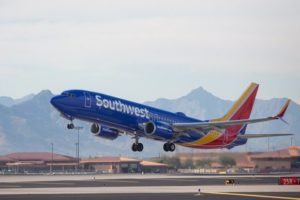Three months ago, West Coast airline operator Alaska Air Group (NYSE: ALK) released a weak fourth-quarter earnings report and a dreadful forecast for 2018. Indeed, Alaska Air’s first-quarter guidance implied that the company would be lucky to break even, after having achieved a double-digit adjusted pre-tax margin in Q1 2017.
Fortunately, Alaska Air Group managed to outperform its initial expectations last quarter. While it will still face severe profit headwinds in the second quarter, Alaska is moving decisively to improve its unit revenue trajectory. Combined with the benefits from easier comparisons and merger synergies, this should lead to much better results in the second half of 2018 and beyond.
Alaska Air ekes out a first-quarter profit
Earlier this month, Alaska Air made several favorable adjustments to its first-quarter guidance. Most notably, it increased its revenue per available seat mile (RASM) forecast by nearly 2 percentage points at the midpoint of the guidance range. Additionally, the company reduced its fuel consumption estimate and held its nonfuel unit cost forecast steady despite facing additional costs related to a new flight attendant contract.
As a result, Alaska was able to remain profitable in the first quarter. On Monday, the company reported adjusted earnings per share (EPS) of $0.14 for the quarter — far below last year’s result of $0.99, but still $0.02 ahead of the average analyst estimate.

Digging deeper into the Q1 numbers, revenue rose 5.3% to $1.83 billion on a 2.1% RASM decline. Meanwhile, nonfuel unit costs rose 5.1%, primarily due to wage increases related to Alaska’s new pilot and flight attendant contracts. Fuel efficiency improved slightly on a year-over-year basis, but the price of jet fuel surged 20% to $2.14 per gallon.
In total, the combination of lower unit revenue, higher nonfuel unit costs, and a higher fuel price caused Alaska Air’s pre-tax margin to decline by nearly 10 percentage points last quarter, falling to 1.3% from 11% a year earlier.
Taking action to improve results
While Alaska Air’s Q1 earnings beat expectations, investors are still justifiably concerned about the collapse in its profitability. However, management isn’t being complacent about the company’s challenges.
Later this week, Alaska Airlines and Virgin America will be integrated into a single airline under the Alaska Airlines brand. This step should unlock more than $200 million of potential revenue synergies that Alaska Air hopes to capture within the next two to three years.
During the earnings call on Monday, Alaska Air’s management also revealed several other initiatives to boost unit revenue. This fall, Alaska Airlines will implement its own version of the “basic economy” fares successfully introduced by its legacy carrier rivals in recent years. It will also make some other policy changes to better align with the rest of the industry and boost ancillary revenue.
Furthermore, Alaska Air is continuing its efforts to cut underperforming routes and shift capacity to better markets. Earlier this month, Alaska revealed tweaks to its schedule at New York’s JFK Airport. It will reduce capacity on the ultra-competitive routes to San Francisco and Los Angeles, while adding a third daily flight to Seattle (where it is the dominant carrier) and a new route to San Jose (an underserved market that it is building into a focus city).
During the earnings call, Alaska Air also announced a deal with archrival Southwest Airlines (NYSE: LUV) that will downsize Alaska’s East Coast presence. Southwest Airlines will lease Alaska’s six slot pairs at New York’s LaGuardia Airport and four of its slot pairs at Washington, D.C.’s Reagan Airport for an initial term of 10 years.

Southwest Airlines plans to expand in New York and Washington, D.C. Image source: Southwest Airlines.
These slots were initially acquired by Virgin America in 2014 and used as part of a small focus city operation at Dallas Love Field. Virgin America had hoped to gain a loyal following among Dallas business travelers by flying to a few key business markets from Love Field. However, fares on these routes plunged, largely due to brutal competition from Southwest. Alaska Air’s efforts to “fix” these markets by using smaller regional jets didn’t deliver sufficient improvement.
This deal with Southwest will probably bring in several million dollars of annual lease income, while eliminating the losses from the Love Field routes. Going forward, Alaska Air will focus on serving its core West Coast markets from Love Field — or it may move all of its operations back to the larger Dallas-Fort Worth International Airport.
Profit declines should moderate after the second quarter
For the second quarter, Alaska Air expects RASM to decline 2.75% to 3.75%, including a 1-percentage-point negative impact from the timing of Easter. Nonfuel unit costs are set to rise by 4.5% to 5.1%, while Alaska’s economic fuel cost per gallon is on pace to surge 32% to $2.25.
This implies that Alaska Air will face even greater margin pressure this quarter than it did in the first quarter, although that is largely caused by the Easter shift. Based on Alaska’s forecast, the company’s pre-tax margin may decline by 11 to 12 percentage points this quarter. However, it earned a 24% adjusted pre-tax margin in Q2 2017, so its second-quarter pre-tax margin will remain comfortably in double-digit territory.
Looking ahead, Alaska Air’s revenue synergies should start to kick in during the second half of 2018. Year-over-year RASM comparisons will also become easier by more than 6 percentage points relative to Q2, while capacity growth will slow. Lastly, nonfuel unit cost inflation is set to moderate.
All of these factors mean that Alaska Air is on track to stabilize its profitability later this year. That will put it in position to return to strong profit growth in 2019 as its various revenue initiatives gain steam.


